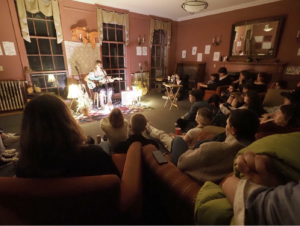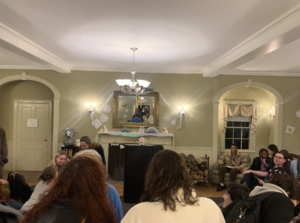A further look into Patti Smith’s classic, Just Kids
It was the summer Coltrane died. Feverish and full of wanderlust, 20-year-old Patti Smith left home in suburban New Jersey for New York City. The long, hot summer of 1967 saw Harlem riots, an East Village crawling with artists, and a new wave of immigrants starting to move into the city. New York was becoming a one-of-a-kind multicultural metropolitan destination, unparalleled anywhere else in the world. During this cultural upheaval, young Patti Smith made her way to Brooklyn, penniless and full of ambition, inaugurating a creative adventure that would last the rest of her life; Smith immediately met Robert Mapplethorpe, her soon-to-be inseparable partner and comrade for the twenty years that followed. The two lived as young artists, gallivanting around New York, in love with each other as much as the city, working to make ends meet. Smith chronicles these stories in her all-consuming memoir Just Kids, as much an account of her relationship as it is an ode to New York.
“It was a good day to arrive in New York City,” Smith writes, fresh off the Hoyt-Schermerhorn subway, where she wanders the brownstone-filled streets looking for her friends, resigned to sleeping on a red stoop when they never show up. Smith tours Fifth avenue, finds Washington Square, crashes in Central Park, and people-watches at MacDougal street cafes, all in her first week. When she meets Robert Mapplethorpe while working at a bookstore uptown, she gains a companion and a friend, with whom she’ll exist alongside while they both search for their artistic voices. They live as floaters, rotating jobs and seeking satisfaction in their crafts, Smith, as a writer, and Mapplethorpe as a photographer.
Throughout the documentation of Patti Smith’s budding career, in Just Kids Smith yearns for her adolescence to go on forever. She self-identifies with Zelda Fitzgerald’s “mutinous spirit” and compares herself to Peter Pan, full of youth and life. Smith makes us as readers feel a unity toward her mindset– “for-youth-by-youth”– resonating with her zeal and drive to make it. Smith proclaims, “Sometimes I just wanted to raise my hands and stop. But stop what? Maybe just growing up.”
Her reluctance to grow up is heavily romanticized, as is most of the memoir— a golden, auspicious, shining reflection of 60s-and-70s downtown New York through the lens of a struggling young artist. But Smith is self-aware enough to see this, and when considering her roughest days, writes, “Romanticism could not quench my need for food.” With high aspirations and lofty creative ambition, Smith centers herself in a time capsule of innocence and childlike wonder, as if she herself as a 20-something running around New York is duplicative of a six year old, running around a toy store, yearning for everything she lays her eyes on. “Who can know the heart of youth but youth itself?” Smith asks, as Mapplethorpe leaves their safe Chelsea Hotel bubble to prostitute himself in a desperate attempt to make money and explore a burgeoning sexual curiosity. The thing Patti seemed to want the most was Robert; her unfulfilled sexual desire toward him akin to a six year old, when she is denied the toys she sought. It is there at the Chelsea Hotel that Smith concedes, “I felt a fleeting pang in my heart for I knew that innocent phase of our life had passed.” Her admission is a painful sting for the reader; Smith’s imprint already iron-hard.
What stands out on nearly every page is Smith’s intelligence. Wickedly smart and quick-witted, she could take on the world. She knows she isn’t meant to be an actor: “I drew no line between life and art. I was the same on- as offstage.” Smith sees it coming before her beau, the playwright Sam Shepherd, leaves her: “We were as close as ever, but it was getting time for him to go.” Smith has an accepting and merciful view on all her disappointments, understanding that what hasn’t worked out had its purposes. This could be a quality she’s acquired with age, reflecting on her youth decades later. However it seems to be something Smith possesses in her 20s, making every step backwards a chance to move forward, in a new or different way. She takes setbacks as directional inspiration, possibly more of the glamorizing mindsets Smith inhabits. Her observations are astute and provocative, and it’s evident that Smith isn’t just experiencing her life as a young artist, she’s surveilling and scrutinizing it, using everything that happens around her as creative ammunition.
Naturally, celebrity enters the book, as Smith chronicles encounters with Salvador Dali, Jimi Hendrix, Janis Joplin, Andy Warhol and more. Jimi Hendrix relates to her on a staircase outside of a party, while Smith contemplates going inside (“Contrary to what people might think, he was shy, and parties made him nervous.”) Salvador Dali sees Smith in the lobby of the Chelsea Hotel and tells her she is like a “gothic crow.” Wherever Patti Smith went, people were enticed by her, mesmerized and interested in knowing more.
Patti recounts that in the beginning of their relationship, Mapplethorpe stole an original William Blake piece, watermarked with his monogram. Blake was an early part of their love story– the pair connected through a mutual admiration of his work. Full of guilt over his theft, Robert shreds the art and flushes it down the toilet. He tells Patty, “At least they’ll never get it.” She asks him who “they” is, and Robert answers: “Anyone who isn’t us.” Their partnership was solid, and they always found their way back together (“Paths that cross will cross again”). Smith’s depiction of Mapplethorpe is disjointed. She tries to characterize him in a good-natured and charismatic light, but he comes across as pretentious, pompous and tortured much of the time. Simultaneously, we can cut him some slack as a 20- year-old finding himself and trying on different roles while he searches for his voice as an artist.
While Smith’s love for Mapplethorpe never dwindles, it is when she has space from him that she changes and blossoms. His needs become a weight on hers (“Robert’s aesthetic became so consuming that I felt it was no longer our world, but his,”) and Smith writes that he transformed their home into a “theater of his design.” When they part ways as lovers, Smith focuses more on herself and her desires. While Smith claims early on she never wants to grow up, it’s when she and Robert are together, at the Chelsea Hotel, in their happiest days, she feels time’s presence the most. “You could feel a vibration in the air, a sense of hastening,” Smith writes. She solemnly but amenably admits, ”Perhaps it was an awareness of time passing.”
Smith paints a vivid portrait of her life, nostalgic and dream-filled. Patti’s gift as a documenter is her way of making you fall for her world like she did. She uses her words as the lens to her infatuation; it’s vivacious, filled with fervor and disillusionment and yearning, and all the things you feel in your 20s, magnified by this star-studded party-land Smith found herself in. However, if you read between the lines, it’s clear this was no accident— Smith didn’t land here, clueless and unprepared. Smith narrates a glittery account of her experiences, which could lead you to think everything that happened to her just happened; yet, that would be a mistake— her writing shows an ambition so zealous it’s for certain that Smith gets what she wants. Her snapshot of her early days pre-New York is unsentimental. Before Patti Smith ran to New York, at home in New Jersey she recounts arguing with her mother about putting a top on while sunbathing, when the boys didn’t have to wear one. Her mother warned her, “You’re about to become a young lady.” Smith, with a penchant for stubbornness and a willful composition, protested. She promised, “I was never going to become anything but myself, that I was of the clan of Peter Pan and we did not grow up.” Smith evokes the excitement of youth, a time where she was able to play different parts and be several different people all the while being herself. Smith found solace in a whimsical, kooky and accepting city, where everyone could be anyone. In Just Kids, Smith is covetous of a world she’s just discovered, learning there is no invitation, you just have to walk right in. Her artistic aspirations and love affair take the center stage, as Smith narrates this written record of her adolescence. Smith calls herself and Mapplethorpe “Hansel and Gretel” venturing out in the world. On his deathbed, Robert asks Patti to write down their story and she keeps her promise, producing this dazzling, evocative portrayal of their lives. “Why can’t I write something that would awake the dead?” Smith asks herself. It’s her last remnant of child-like bewilderment to be found in the book. Ultimately, Smith grows up, leaving Neverland but staying in New York. Although the real Patti Smith matured and did in fact age, her youth is preserved through the book itself. With Just Kids, Patti gets to live on forever young, immortalizing her youth through elegy.








Be First to Comment